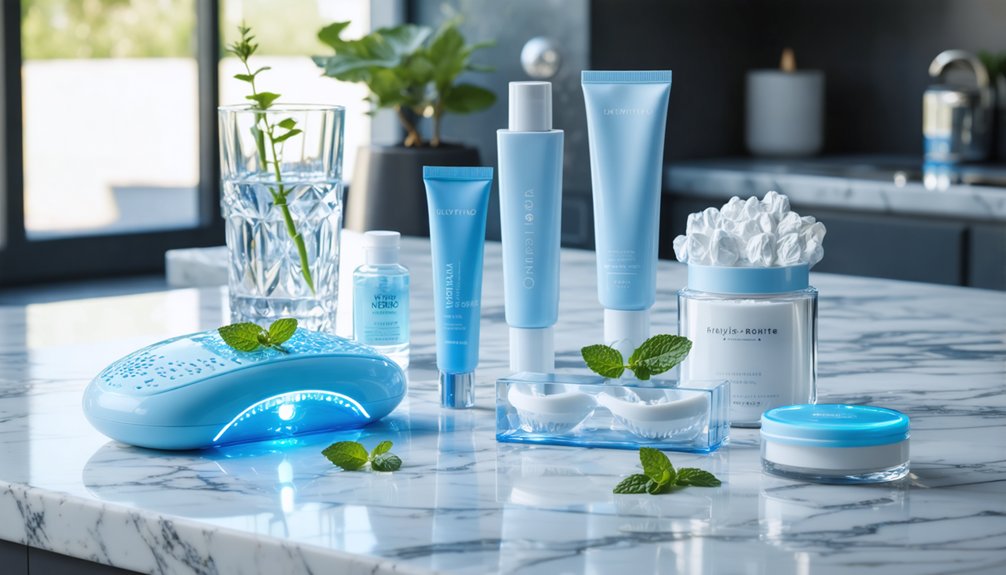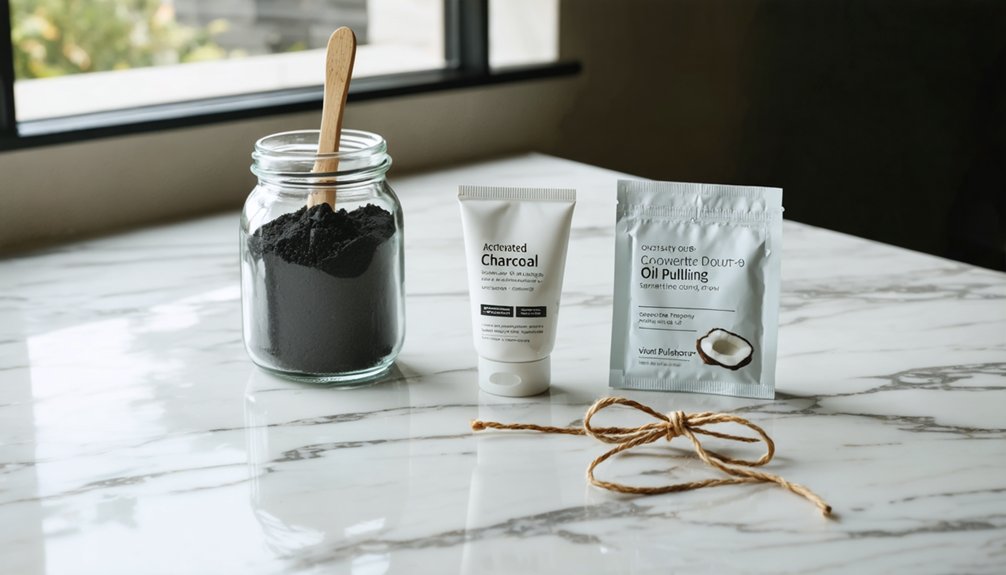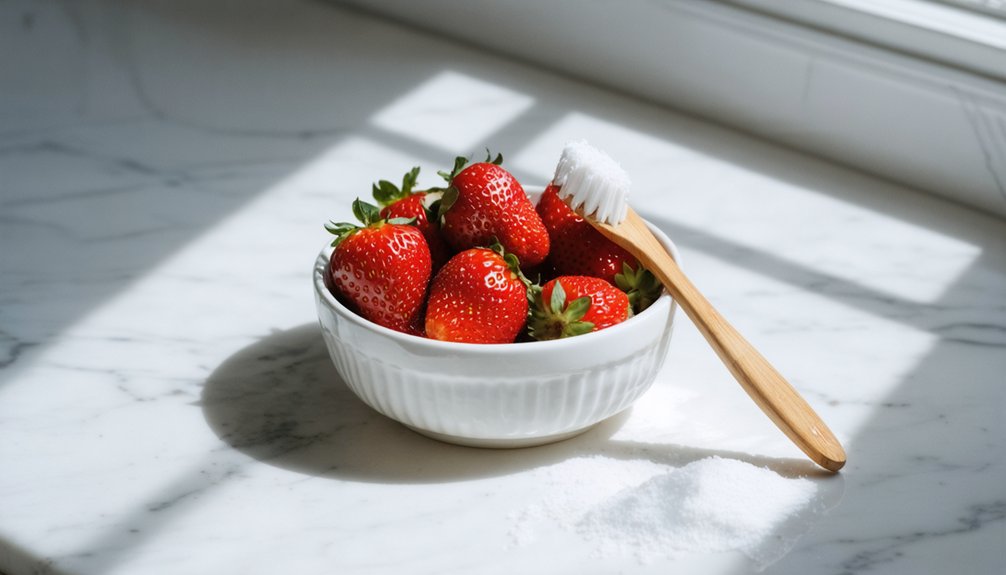For sensitive teeth, you’ll find several effective whitening options that minimize discomfort. Professional treatments like Zoom whitening and laser activation offer controlled, supervised results, while custom-fitted trays provide gentle at-home care. Low-peroxide strips, PAP systems, and sensitivity-safe rinses deliver gradual improvement. Desensitizing whitening toothpaste, baking soda methods, and oil pulling present natural alternatives. ADA-approved products combining whitening agents with desensitizing compounds guarantee both safety and results. Understanding each method’s unique benefits will help you choose the ideal solution for your needs.
Key Takeaways
- Custom-fitted dental trays with professional-grade whitening gel offer controlled application and minimized sensitivity through precise fit and personalized concentrations.
- Gentle whitening strips with low peroxide concentrations (6% hydrogen peroxide) are suitable for sensitive teeth when used in short 5-10 minute sessions.
- Desensitizing toothpaste with whitening properties combines tubule-blocking agents and gentle stain removal for gradual, comfortable whitening.
- Non-peroxide PAP whitening systems break down stains without releasing harmful free radicals, making them ideal for sensitive teeth.
- Sensitivity-safe whitening rinses with low peroxide concentrations (below 1.5%) provide gradual whitening while maintaining comfort for sensitive teeth.
Professional Zoom Whitening Treatment
Professional Zoom Whitening is a cutting-edge dental procedure that delivers dramatic teeth whitening results in a single office visit.
Before beginning treatment, your dentist will conduct a comprehensive dental exam to ensure you’re a suitable candidate. During the one-hour treatment, your dentist will protect your lips and gums before applying a specialized hydrogen peroxide gel three times for 15-minute intervals. A UV-filtered LED light activates the gel, penetrating deep into your enamel and dentin to break down stubborn stains. Professional supervision ensures your safety and customized treatment throughout the process.
The Zoom advantages include faster, more effective whitening compared to at-home methods, while treatment safety remains a top priority.
The procedure’s careful design makes it suitable for most people with sensitive teeth. Your dentist will apply a fluoride or desensitizing gel afterward to minimize discomfort.
You’ll notice considerably whiter teeth immediately, with results lasting six months to three years when properly maintained.
Custom-Fitted Dental Trays
When seeking a personalized teeth whitening solution, custom-fitted dental trays offer exceptional results while prioritizing comfort and safety.
These trays’ precise fit guarantees uniform gel distribution across all tooth surfaces, including hard-to-reach areas and uneven teeth that strips can’t effectively treat.
Among the custom tray advantages, you’ll find professional-grade whitening gel effectiveness that surpasses over-the-counter options.
The snug fit minimizes gel contact with gums, reducing sensitivity and irritation while maximizing the whitening power on your teeth.
While the initial investment ranges from $300 to $600, the professional consultation and included gel supply make custom trays worthwhile.
Treatment typically requires daily wear for 2-4 weeks to achieve noticeable whitening results.
You’ll appreciate the flexibility to whiten at home, controlling treatment frequency and duration based on your comfort level.
The trays are reusable for maintenance sessions, making them a cost-effective choice in the long run.
For sensitive individuals, this gradual approach provides excellent results without the discomfort of intensive in-office treatments.
Gentle Whitening Strips With Low Peroxide
While standard whitening strips can trigger significant discomfort, gentle strips with low peroxide concentrations offer a milder approach for those with sensitive teeth.
Studies show that 54% of patients experience mild sensitivity during bleaching treatments, making proper product selection crucial.
Look for products containing around 6% hydrogen peroxide or 18% carbamide peroxide, as these gentle formulations minimize irritation while still providing whitening benefits.
You’ll want to start with brief 5-10 minute applications to assess your sensitivity tolerance. If you don’t experience discomfort, you can gradually increase the duration.
The tiny tubules in your teeth’s dentin layer are what make them sensitive to whitening agents, so choosing the right concentration is essential.
The peroxide concentration is key – don’t be swayed by marketing claims about natural ingredients or cooling sensations.
Focus on the peroxide percentage when choosing whitening strips – marketing buzzwords about natural additives won’t determine effectiveness.
Monitor your gums carefully, ensuring the strips only contact your teeth. If you experience persistent sensitivity, consider consulting your dentist for professional alternatives.
Remember that any discomfort is typically temporary and should resolve within days after treatment.
Desensitizing Toothpaste With Whitening Properties
You’ll find that desensitizing toothpastes with whitening properties offer protection through both tubule-blocking agents like arginine and nerve-calming ingredients like potassium nitrate.
These dual-action formulations can effectively reduce sensitivity while gradually whitening your teeth through gentle stain removal mechanisms. The recommended one-inch strip application ensures proper dosage for optimal effectiveness.
Many Sensodyne products contain stannous fluoride protection which forms a shield over exposed dentin while fighting surface stains.
For ideal results, brush twice daily with a soft-bristled toothbrush using gentle circular motions, allowing the active ingredients to fully contact your teeth for at least two minutes.
Dual-Action Protection Benefits
For individuals with tooth sensitivity, dual-action toothpastes offer a groundbreaking solution by combining desensitizing compounds with whitening agents. Radiant smiles make a significant impact on overall appearance and confidence levels.
These innovative formulations effectively address both cosmetic concerns and discomfort without compromising whitening efficacy. Professional dental consultation is essential before starting any whitening treatment to ensure the best product selection for your sensitivity level.
Key benefits of dual-action protection include:
- Desensitizing agents like potassium nitrate and arginine block pain signals while allowing whitening to occur.
- Occlusive ingredients seal exposed dentin tubules, preventing sensitivity triggers during treatment.
- Combined formula maintains whitening performance while reducing dropout rates due to discomfort.
- Regular use strengthens enamel through fluoride incorporation while achieving desired cosmetic results.
You’ll find these multi-benefit toothpastes particularly valuable when preparing for professional whitening treatments or maintaining results while managing sensitivity long-term.
Recommended Application Methods
To maximize the effectiveness of desensitizing whitening toothpaste, proper application technique is essential for achieving ideal results. You’ll need to brush twice daily for approximately three minutes, ensuring you cover all tooth surfaces to properly distribute the desensitizing agents.
Start using your desensitizing toothpaste two weeks before beginning any whitening treatment. Apply moderate pressure with gentle brushing motions to prevent enamel wear while maintaining whitening efficacy.
Continue this regimen throughout your whitening process and for several weeks afterward to maintain reduced sensitivity levels.
For enhanced protection, combine your brushing routine with a fluoride mouth rinse after each session. This combination helps alleviate sensitivity while promoting enamel repair, creating favorable conditions for both comfort and whitening results.
Non-Peroxide PAP Whitening Systems
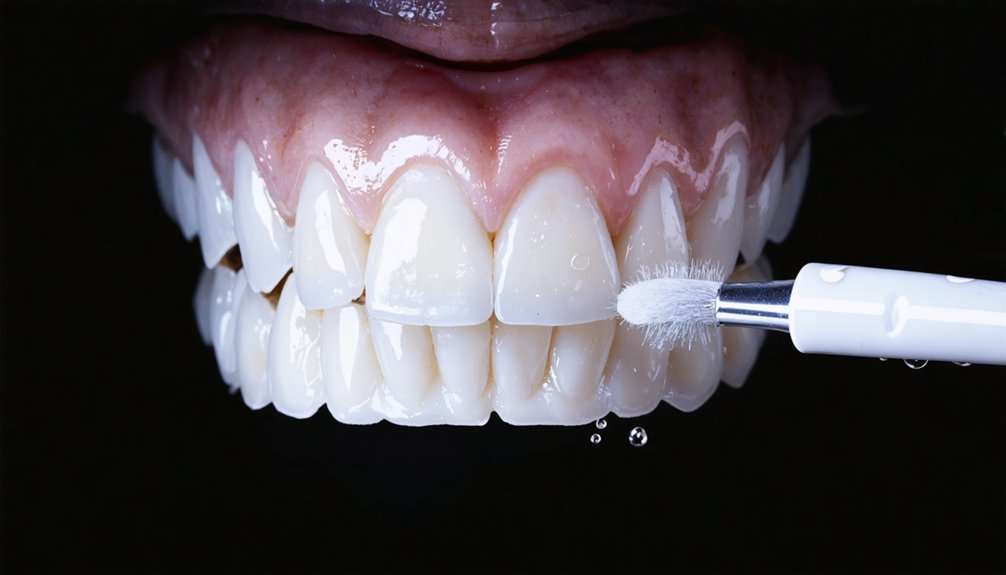
PAP (phthalimidoperoxycaproic acid) breaks down stains through gentle oxidation without releasing harmful free radicals into your tooth structure.
You’ll experience safer whitening because PAP systems target surface stains while minimizing penetration into sensitive enamel layers.
For ideal results with PAP whitening products, you should apply them consistently according to package directions, typically once or twice daily, while avoiding excessive use that could still trigger mild sensitivity.
PAP Working Mechanism Explained
While traditional teeth whitening systems rely on peroxide-based compounds, modern PAP whitening technology utilizes a unique mechanism of action through Phthalimido-Peroxy-Caproic Acid.
The key PAP benefits stem from its targeted oxidation process, which breaks down stain molecules without generating harmful free radicals.
Here’s how PAP works to whiten your teeth:
- Directly targets chromogens (stain molecules) through controlled oxidation reactions
- Breaks large pigmented molecules into smaller, colorless compounds
- Oxidizes dietary polyphenols that cause surface staining
- Performs Baeyer-Villiger oxidation on ketones within stains
You’ll experience effective whitening without the sensitivity often associated with peroxide treatments, as PAP’s mechanism preserves enamel integrity while transforming stains into colorless compounds.
Safe Application Guidelines Daily
Despite their gentler formulation compared to peroxide-based products, non-peroxide PAP whitening systems still require careful adherence to safety guidelines for best results.
For ideal sensitivity management, limit your daily application to 15-30 minutes. If you experience any gum irritation or tooth sensitivity, pause treatment until symptoms subside.
You’ll achieve better enamel protection by using PAP products 3-5 times weekly rather than daily, allowing recovery time between sessions.
Choose systems containing protective ingredients like fluoride or hydroxyapatite for enhanced enamel strength.
You’ll also benefit from using a desensitizing toothpaste alongside your whitening treatment.
Don’t proceed with PAP whitening if you have untreated decay, gum disease, or cracked teeth – address these issues first through professional dental care.
Laser-Activated Whitening Sessions
For individuals seeking rapid teeth whitening results, laser-activated treatments represent one of the most advanced professional solutions available today.
When administered by trained professionals, these sessions offer significant laser treatment benefits while maintaining strict laser safety precautions for sensitive teeth.
Key aspects of professional laser whitening include:
Professional laser whitening combines expert techniques, advanced technology and personalized care to deliver superior teeth whitening results safely and effectively.
- Faster results through controlled heat activation of bleaching gels, often achieving dramatic improvements in a single session.
- Customized treatment protocols using specific laser wavelengths and power settings to minimize sensitivity.
- Enhanced safety through chromophore-containing gels that limit pulp temperature increases.
- More uniform and longer-lasting results compared to traditional whitening methods.
Your dentist will carefully monitor the entire process, adjusting laser settings and application times to guarantee ideal results while protecting your comfort and dental health.
Color-Neutralizing Dental Products
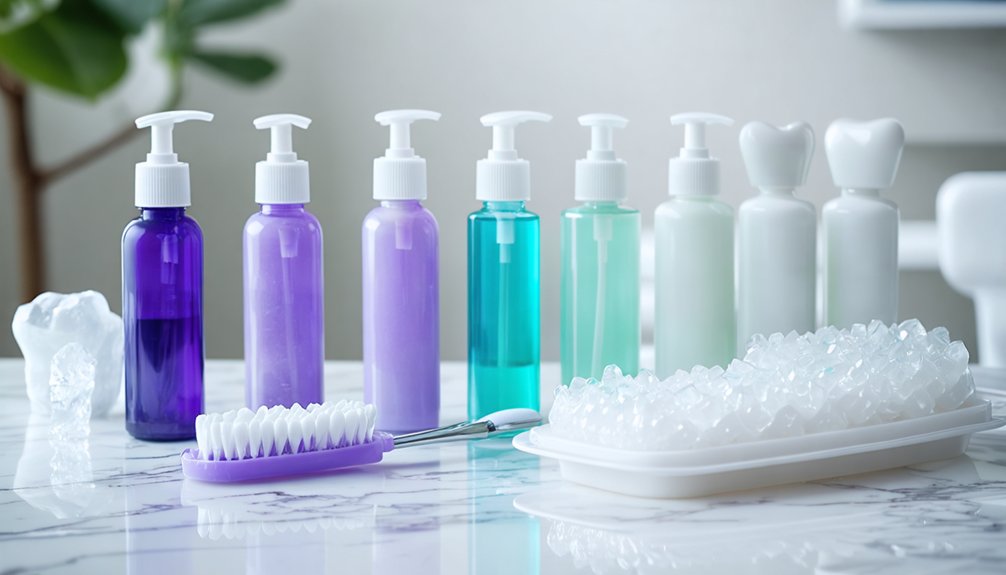
Modern color-neutralizing dental products represent a gentler approach to teeth whitening compared to laser treatments.
You’ll find several effective ingredients that provide color neutralizing properties while protecting sensitive teeth. Baking soda offers gentle abrasiveness for surface stain removal while neutralizing harmful acids. Activated charcoal powder naturally lifts stains without compromising enamel integrity.
For enhanced protection, look for products containing calcium and phosphate ions, which help remineralize your enamel after whitening treatments. These mineralizing agents work particularly well when combined with low-concentration hydrogen peroxide formulas.
If you have sensitive teeth or gum recession, opt for products featuring potassium nitrate or stannous fluoride. These ingredients seal dentinal tubules while still providing effective stain removal and whitening benefits.
Sensitivity-Safe Whitening Rinses
While traditional whitening treatments often cause discomfort, sensitivity-safe whitening rinses offer a gentler approach through their low-concentration peroxide formulations. For those with sensitivity concerns, these rinses typically contain hydrogen peroxide levels below 1.5% and include stain-preventing agents that work gradually to brighten your smile.
Here’s what you need to know about using whitening rinses effectively:
- Brush before rinsing to enhance contact between whitening agents and teeth
- Swish for 60 seconds twice daily for ideal results
- Don’t rinse immediately after use to maximize whitening potential
- Expect gradual results over 4-12 weeks of consistent use
While these rinses may not deliver dramatic results like professional treatments, they’re a safer option for patients with sensitive teeth who need long-term whitening maintenance.
Dentist-Supervised Home Whitening Programs
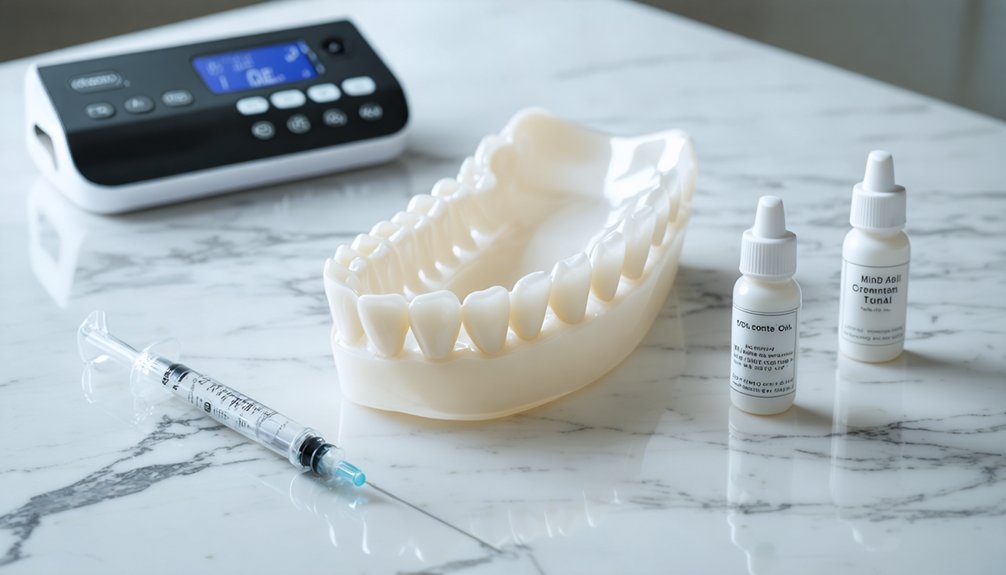
Dentist-supervised home whitening programs represent a significant advancement beyond basic whitening rinses, offering a professional approach that combines effectiveness with sensitivity management.
You’ll receive custom-fitted trays created from precise impressions or digital scans, ensuring uniform application of low-concentration peroxide gels. This personalized whitening approach minimizes gum contact while maximizing results.
Your dentist will monitor your progress and make comfort adjustments as needed, including modifications to wear time and gel strength.
The professional-grade gels contain desensitizing agents like potassium nitrate or fluoride, and you’ll follow specific pre-treatment protocols to strengthen your enamel.
Your dentist will guide you through proper usage, helping you avoid common irritants during treatment while achieving longer-lasting results with minimal sensitivity compared to over-the-counter options.
Natural Stain-Removal Methods
When exploring gentle whitening options for sensitive teeth, you’ll find several natural methods backed by varying levels of evidence, including oil pulling with coconut oil, which helps reduce bacteria and surface stains.
You can try baking soda mixed with water as a mild abrasive that safely removes surface discoloration without damaging sensitive enamel when used correctly.
While activated charcoal has gained popularity, you should approach it with caution and stick to scientifically supported methods like oil pulling and careful baking soda use for the safest results.
Oil Pulling Benefits Explained
Oil pulling, an ancient Ayurvedic practice dating back 2,500 years, has gained modern attention for its potential oral health benefits.
Research shows that this technique offers antimicrobial activity, reducing bacterial colonies in your mouth when practiced correctly. While it shouldn’t replace your regular oral care routine, oil pulling can complement your existing practices.
Key benefits you’ll experience with consistent oil pulling:
- Significant reduction in oral bacteria, potentially improving breath freshness
- Mild anti-inflammatory effects that may soothe gum tissue
- Possible relief from dry mouth symptoms and chapped lips
- Gentle surface stain removal, though not comparable to professional whitening
For best results, use coconut or sesame oil for 5-20 minutes daily, and remember not to swallow the oil after swishing.
Activated Charcoal For Whitening
Activated charcoal has emerged as a popular natural whitening trend, though scientific evidence reveals significant limitations and potential risks. While it may remove surface stains through abrasion, studies show its effectiveness doesn’t match conventional whitening toothpastes, especially those containing hydrogen peroxide.
The safety concerns of activated charcoal are significant. Its high abrasiveness can erode enamel, leading to increased sensitivity and potential yellowing.
You’ll also find most charcoal toothpastes lack fluoride, compromising your cavity protection. If you have dental work, be cautious – charcoal particles can accumulate in restoration margins and cause unsightly staining.
For sensitive individuals seeking whitening solutions, activated charcoal’s risks may outweigh its limited benefits. Consider discussing alternative whitening methods with your dentist that won’t compromise your oral health.
Baking Soda Stain Removal
Baking soda offers a gentle yet effective natural approach to teeth whitening for those with sensitive teeth. Its mild abrasive properties help remove surface stains while its alkaline nature neutralizes harmful acids in your mouth.
When considering baking soda benefits for teeth whitening, remember that it’s particularly effective against extrinsic stains from coffee, tea, and tobacco.
- Mix baking soda with water in a 1:1 ratio to create a safe, non-abrasive paste
- Brush gently with a soft-bristled toothbrush for two minutes
- Rinse thoroughly to maintain proper oral pH balance
- Use consistently for gradual whitening results
Important baking soda precautions include avoiding direct application of the powder and never replacing your regular fluoride toothpaste.
For best results, consider ADA-approved toothpaste containing baking soda, especially if you have sensitive teeth.
Frequently Asked Questions
How Long Should I Wait Between Whitening Treatments to Prevent Increased Sensitivity?
For proper sensitivity management, wait at least six months between professional whitening sessions and two months between at-home treatments. You’ll protect your enamel while maintaining ideal whitening frequency.
Can Certain Medications Affect Tooth Sensitivity During Whitening Procedures?
Yes, your medications can impact sensitivity levels during whitening. Antibiotics like tetracycline can affect tooth structure, while medications causing dry mouth or inflammation may heighten your discomfort during treatment.
Does Drinking Through a Straw Help Prevent New Stains After Whitening?
Like a shield deflecting arrows, your straw benefits include reduced contact between staining drinks and teeth. While it’s helpful for stain prevention, you’ll still need proper placement and complementary protective measures.
Are Whitening Results Permanent for People With Naturally Sensitive Teeth?
Your whitening results won’t be permanent, regardless of tooth sensitivity. With proper sensitivity management, you’ll need periodic touch-ups to maintain whiteness, just like anyone else seeking long-term whitening longevity.
Should I Avoid Specific Foods Before Starting a Teeth Whitening Treatment?
You’ll want to avoid foods high in teeth staining potential and food acidity 24 hours before whitening begins. Skip dark berries, citrus fruits, tomato products, coffee, tea, and wine.
References
- https://www.purpleplumdentistry.com/post/best-teeth-whitening-options-for-sensitive-teeth
- https://www.westriverdentalcare.com/best-teeth-whitener-for-sensitive-teeth/
- http://www.goochlanddentistry.com/whats-the-best-teeth-whitener-for-sensitive-teeth/
- https://buforddentist.com/what-are-the-best-whitening-options-for-sensitive-teeth/
- https://nhdentistrybeverlyhills.com/press/6-of-the-best-teeth-whitening-kits-in-the-drugstore/
- https://truesmileworks.com/which-teeth-whitening-method-is-best-for-sensitive-teeth/
- https://globalnews.ca/the-curator/10176919/teeth-whitening-sensitive-teeth/
- https://www.yourdentistryguide.com/zoom-whitening/
- https://smilesbyvivid.com/resources/zoom-teeth-whitening/
- https://www.healthline.com/health/dental-and-oral-health/zoom-teeth-whitening
